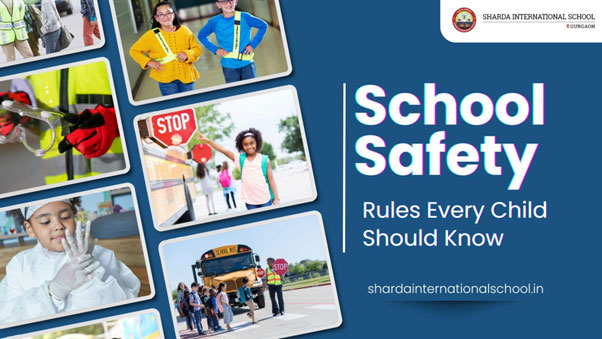School Safety Rules Every Child Should Know
 Every parent feels a pang of worry when their child leaves for
school. It’s natural—you want your little one to explore, learn,
and grow without facing any harm. But here’s the thing: while
schools take extensive measures to ensure safety, it’s equally
important for children to be aware of how they can protect
themselves. Teaching kids simple, actionable school safety rules
can go a long way in empowering them to stay secure and make wise
decisions, even when no one is watching.
Every parent feels a pang of worry when their child leaves for
school. It’s natural—you want your little one to explore, learn,
and grow without facing any harm. But here’s the thing: while
schools take extensive measures to ensure safety, it’s equally
important for children to be aware of how they can protect
themselves. Teaching kids simple, actionable school safety rules
can go a long way in empowering them to stay secure and make wise
decisions, even when no one is watching.
This isn’t about instilling fear—it’s about building confidence.
Let’s dive into the essential safety rules every child should know
to make their school experience safe and enjoyable.
School Safety Rules Children Must Be Aware About
1. Pay Attention During Emergency Drills
Have you ever asked your child what they think about fire or
earthquake drills? They might shrug and say it feels like an
“extra break.” But these drills are crucial. Knowing how to
evacuate quickly or where to hide during a lockdown can save
lives.
The key is for kids to treat these practices seriously and
remember the steps: listen, stay calm, and act swiftly.
Pro Tip for Parents: Make it relatable. At home,
compare these drills to superhero training. After all, superheroes
are always prepared!
2. Be Cautious Around Strangers
Remember the classic "stranger danger" lesson? It’s still relevant
today and equally for school safety. While schools monitor
visitors, children should know not to trust unfamiliar faces
easily. They should avoid walking away with someone who isn’t a
parent, relative, or teacher.
Here’s a quick role-play idea: Act out scenarios with your child
where someone pretends to be “sent by Mom.” This simple activity
can sharpen their instincts and teach them how to respond
confidently.
3. Follow Road Safety Rules
Whether it’s crossing the road or riding their bike to school,
road safety is non-negotiable. Teach children to always use
crosswalks, look both ways, and never run across the street—even
if they’re late. For cyclists, wearing a helmet is a must, no
exceptions.
School safety can also support this by organizing road safety
workshops, making it both fun and educational.
4. Respect Personal Space and Belongings
Kids can sometimes be a little too carefree with their stuff.
Backpacks are left lying around, lunchboxes forgotten, and gadgets
shared recklessly. Teaching them to value their belongings doesn’t
just prevent loss—it also instills a sense of responsibility.
Label their items with their name, and remind them not to lend
personal items like water bottles or devices. A friend recently
discovered her child’s tablet had been swapped with another
student’s during recess—a small lesson, but one that reinforces
this rule.
5. Prioritize Hygiene for Health Safety
Health is an underrated part of school safety. Regular
handwashing, especially before meals or after playtime, can
significantly reduce the spread of germs. Simple practices like
using tissues when sneezing, avoiding shared utensils, and keeping
their hands away from their face are good habits to teach early.
Post-pandemic, this rule feels more relevant than ever. Carrying a
small hand sanitizer in their bag is a great backup if soap isn’t
available.
6. Know Your School’s Layout
Getting lost in a big school building can feel overwhelming for
younger children. Encourage them to familiarize themselves with
the layout—know where the nurse’s office is, find the nearest
restroom, and remember emergency exits.
7. Stay Safe on the Playground
Playgrounds are where the magic happens—friendships are formed,
games are invented, and memories are made. But they can also be
where accidents occur. Teach children to wait their turn on
slides, avoid roughhousing, and stay clear of swings in motion.
A teacher often tells students, “Fun is best when it’s safe.” Kids
can still enjoy every moment while being mindful of their
surroundings.
8. Speak Up About Bullying
Bullying can be subtle—a whispered insult—or overt, like physical
aggression. Either way, children should feel comfortable reporting
it to a trusted adult. Teach them that asking for help isn’t
tattling; it’s standing up for themselves or others.
One approach is role-playing scenarios at home, where they
practice responding to bullying. A simple “I don’t like that. Stop
it.” can sometimes disarm the situation.
9. Be Smart About Digital Safety
Technology is an integral part of modern classrooms, but it comes
with its own risks. Children should avoid sharing personal details
online, never click on suspicious links, and report any
uncomfortable messages to their teacher or parent.
Consider it a digital version of “stranger danger.” school safety
can reinforce this by maintaining secure networks and teaching
basic cybersecurity practices.
10. Trust Your Instincts
Perhaps the most underrated rule of all: teaching kids to trust
their gut. If something doesn’t feel right—whether it’s a
situation, a person, or an environment—they should know it’s okay
to step back and seek help.
This simple yet powerful lesson can empower them to navigate
tricky situations independently while ensuring their safety.
Why School Safety Matters
School safety isn’t just about preventing accidents or handling
emergencies—it’s about creating an environment where children feel
confident and cared for.Top Schools of Gurgaon
like Sharda International School make their
children understand these rules, the better equipped they’ll be to
navigate challenges independently.
Sharda International School believes that a safe child is a happy
learner. We collaborate with parents equally and we strive to
provide an environment where safety is second nature. After all,
when children feel secure, they can truly thrive.